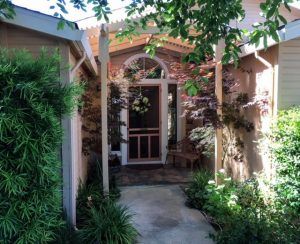What are You Experimenting with this Year?
Experimenting is a great way to have fun in the garden. When trying new things, the idea of “experimenting” removes the stigma of possible failure. It frees us to try new things in new places, learning as we grow. I know a woman who grows something new every year (one year it was cotton)! A friend of mine is experimenting with flowers from seed this year. I’m playing around with gardening vertically. My new “canvas” is in our Oak Memorial Garden where we took down an 80-year-old tree.
For vertical gardening, we repurposed some leftover 6-foot fencing into two-foot diameter circles and staked them in the ground around a mound planted with cucumber seeds. Cucumbers like to grow up, with support, and it keeps the vegetables off the ground, where they are vulnerable to rot, and makes them easier to pick. However, I should have planted the seeds on the outside of the wire. Now I’m going to have to gently tease the plants through the fence to the outside. Challenge!
I’ve also got my red ladder set up next to our fence for squash to grow up. It makes a colorful and sturdy trellis for larger squashes (tromboncino and kabocha). The tromboncino, a previous successful experiment, produces large, beautiful, trumpet-shaped squashes, with orange flesh similar to zucchini. The Kabocha is new to us this year. Taking 90 days to maturity, it’s an experiment – with the shorter growing season at our higher elevation – to see if it makes it to maturity.
Experimenting with what you’ve got can be interesting. From our oak, we have a number of 3-foot-tall rounds, completely hollow (the reason for removing the tree). These rounds have given us decorative places where we’ve put pots planted with snapdragons and petunias. In our oak garden, we’ve created a vernal pool which filled with rainwater during the winter. Now its dry and I’m waiting for a creative idea to fill, or disguise, that hole in the ground. But it was fun during the winter and spring.
Deciding what’s important to you is a good way to start experimenting. Choose something that interests you, research whether it’s suitable for your area, determine how much energy it requires and whether that matches the energy you have to give. Is it something that you can share with others?
Not all experiments succeed. When we first moved up here from the East Bay area, I brought all my beloved dahlias with me. However, this climate is not an easy one for growing them. With our winters, they need to be dug up, stored properly and replanted in spring. The bloom time up here is not enough to offset the effort. So, I’m experimenting with zinnias, cosmos, and crocosmias. Poppies and iris that moved with us are so successful, I’m looking for victims to share them with.
One very successful experiment is our fountain that splashes out into the yard. This uses more water than I like, so I planted flowers all around it. Now it’s still beautiful and the flowers thrive without supplemental watering. And I get to enjoy the fountain that my son gave me.
There are so many things to try. What about three sisters – corn, climbing beans and squash – all coexisting? Or, there are sunflowers whose stalks can support vines like green beans or peas (I save the stalks).
What are you experimenting with this year?
Nancy Bliss is a University of California Cooperative Extension Master Gardener of Tuolumne County.

